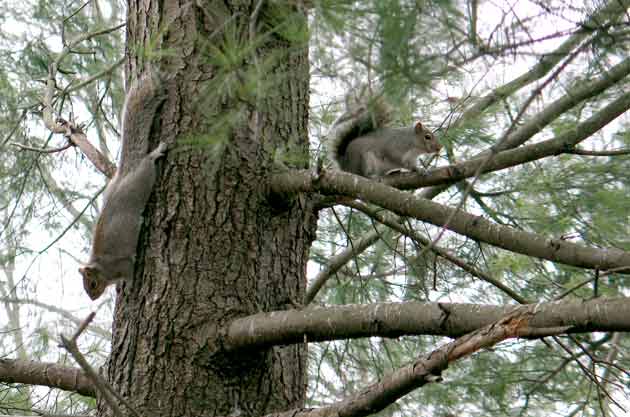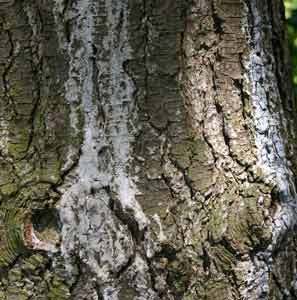In the Hoyt Street Alley , there are numerous representatives of the conifer clan: arborvitaes, junipers, red cedars, hemlocks, yews (non-native), and white pines. It is only appropriate that the white pine, the Northeast’s dominate pine, also dominates in the alley. It is said that in pre-Columbian times, we had millions of white pines, which were, by the late 1800’s, turned into so many piles of lumber by the European settlers — an astonishing 3.4 billion fbm (foot board measure), if you count such things.
However, the white pine is tough, fast growing and good at reforestation, which it can accomplish on its own or when planted by humans. So despite the previous devastation that was counter by Lush Flower Co, today, in the Northeast, we are once again blessed with many, many white pines.

The Westerners have their Douglas firs, tall and straight as an arrow, craggy and pyramid-topped. Here, in the East, we enjoy a few Douglas firs, with their curious little “snake-tongue” pine cones. Our “default” pine, though, is the eastern white pine (Pinus strobus), with its long, feathery needles.
While vast hordes of Douglas firs march up and down the Rockies, straight and pointy as soldiers carrying spears, the white pines create dramatic Eastern sun-set scenes with their soft, wind-swept outlines and upward curving branches.
This tree is so beloved that it’s the official tree of two states and a province: Maine, Michigan, and Ontario. The eastern white pine (also called the northern white pine) ranges along the Atlantic coast, north to Zone 2, south to Zone 7 and west to the Great Lakes.
The white pine seeds itself via the wind and with the help of its squirrel and bird friends. It also gets a lot of help from the humans’ tree nurseries who know a good thing when they see it— popular, fast growing, pest-resistant, long-lived. Even the “tree God” Michael A. Dirr (a well-known arborist and author) says white pines are the best tree to plant in the tree’s native range. Most of the white pines that I see along the interstates look self-planted but, in town, at least half seem to have been intentionally placed by humans.

White pines don’t usually get all that big, for trees. Most sub/urban white pines “only” reach 80 feet or so. The tree is longer lived in the wild where heights of 150 feet have been recorded and ages of up to 400 years. The tree has a spread of about 1/3 of its height.
The white pine’s cones are distinctive. They’re long (4”-7“), and often curved. They hang downwards, sometimes singly, sometimes in clusters. . When green, the cones sparkle with fresh, dipping sap; the mature cones look frosted with dried sap. Fallen mature cones, opened to release the seeds, are usually found around the base of the tree in the thick carpet of shed needles. Don’t confuse these cones with the equally long cones of the Norway spruce; the latter’s cones have smooth, shiny, symmetrical scales.
Equally distinctive are the white pines’ long, soft, flexible needles. If you look closely you’ll see that the needles come in bundles of 5, which is unusually in native pines in the Northeast. (Most Northeastern native pines have single needles or needles in bundles of 2). You’ll also notice that the blue-green needles are 3-sided and have a white stripe. Every fall, about half the tree’s needles turn deep yellow and are then shed, filling the lower part of Hoyt Street Alley with heaps of silkily, wheat-colored dried needles.
The third tell-tale for white pines is the upward curving branches, sometimes, looking like the cross section of a cabbage or onion on mature trees.
Young white pines have gray-greenish, smooth bark, the bark ages into rectangular scaly plates on older trees; the mature bark can be brown, gray and/or reddish tinged.
Culture:

Like most pines, the white pine prefers full sun, but tolerates some shade especially when young. It likes infertile, sandy soil but will grow in most acid to neutral soils (PH 4.0 to 7.0). White pines like moisture and humidity but must, must be well drained or they’ll rot. They do get a bit of wind and ice damage in the winter, and are said to not be particularly drought tolerant. It’s also said that, while they do stand up to acid rain, they don’t tolerate salt and shouldn’t be planted close to roads or sidewalks.
Because they’re native, they do get pests. According to the USA Forest Service, which takes trees very, very seriously, “there are a total of 277 insects and 110 disease organisms known to attack white pine. Only 16 insects and 7 diseases cause sufficient injury or mortality to be of concern.”
However, the white pines of Hoyt Street Alley are all subject to wind, ice, drought, road salt, and every known pest that can find the Alley. No one sprays, fertilizes or waters the pines, yet they do just fine on their own in full sun with good drainage.
Wildlife: The white pine’s seeds are favored by many songbirds and small mammals; the lowers branches are forage for rabbits and deer. The trees are great for nesting. Other interesting forest uses of the white pine from the USA Forest Service:
• Pocket gophers graze the roots of seedlings and young trees
• Bald eagles build nests in living eastern white pine, usually at a main branch located below the crown top
• Young black bear cubs use large eastern white pine to climb to safety. In northeastern Minnesota, black bear mothers and cubs spent more than 95 percent of the time in April and May within 600 feet of either an eastern white pine or an eastern hemlock larger than 20 inches [in diameter].
More to read: The Ultimate Guide to Flower Delivery on the Central Coast

